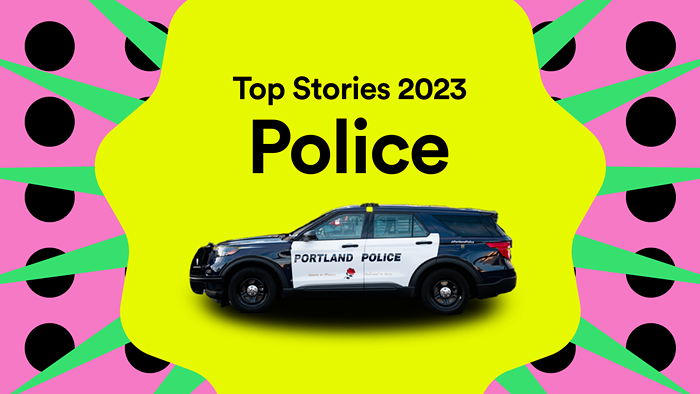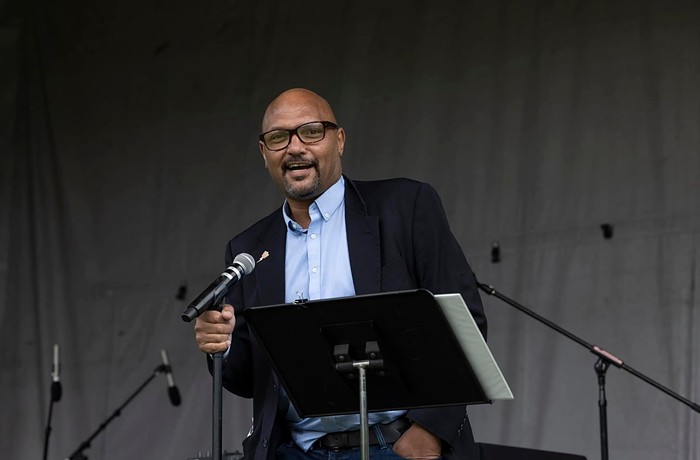"WHAT THINGS in American history do we long to get back to?" asks Annie McLaughlin. This was a question she mined extensively while constructing the images in her solo show at Open Gallery, The Good the Bad and the Ugly. Inspired by the resurgence of craft culture ("urbanites who are suddenly interested in basket weaving"), and the particular kind of nostalgia that leads you to Instagram your cool vintage Thermos on a camping trip, the paintings surrounding us reckon with the search for authenticity, while inhabiting "the blurred space between celebration and criticality."
In a color palette of peach and ochre, with oversized brush strokes and drop shadows meant to evoke painted signs along the highway, McLaughlin's work fuses an exalted American pastoral (wide expanses, Ansel Adams, things posted to Instagram without irony) and kitschy West Coast Americana (pink motels, Spaghetti westerns, things posted to Instagram with a large dose of irony).
"Why Do We Bathe? How Nude Are We? What Are We Even Doing, Dude?" gestures strongly toward Western art history's surplus of idyllic bath-time-in-a-clearing scenes, with 1970s SoCal commune vibes thrown in for good measure. The show also features a trinity of archetypal figures transformed into off-kilter avatars: a cowboy in "Twilight Wrangle (Where the Buffalo Roamed"), a potter in "Big Pot Boogie (A Cumbersome Burden)," and a shepherd in "Buddy Bucolic and a Lil Lamb, Too," each wearing a crooked, almost drunken-looking but utterly benign grin.
Founded in the summer of 2014 on the seam between Old Town/Chinatown and the Pearl District, Open Gallery is the modest storefront in what's primarily a studio space, maintained and curated by a collective of local artists who don't publicly identify themselves individually. Portland painter Lora Baize is the collective's only exception to this code of anonymity: As the public face of the gallery, she handles the space's minimal PR, and sets up visits like mine.
As we look up at The Good the Bad and the Ugly, Baize assures me that McLaughlin can paint realistically, too, but I can already tell. Though McLaughlin's approach is clearly cartoonish, there are gestures in each of her pieces—the just-right brush stroke that forms the cowpoke's boot, the accurate proportions of the shepherd's charges—that are much too precise in placement to read as accidental or amateurish. The paintings are silly, sure. Taking in the scale of the portrait of the potter—the pot dwarfs its maker, who grins, hugging it—I actually laughed out loud. Meanwhile, McLaughlin herself points out the awkwardness of her shepherd figure, who seems to struggle to balance his lamb and a comically large staff in his right hand, as he considers a flower in his left. It's a welcome injection of the practical-yet-still-absurd into a tired trope: It's all well and good to reflect on the romance of the natural world if you're in a painting, but you still have to carry your sheep around.
McLaughlin's paintings resemble what might happen if you took a photorealistic image of an iconic scene of the West, put it through a paint machine, stripped it of all but the most basic detail, and shoved an emoji smiley face on top of it, all without ever teetering into complete abstraction. McLaughlin's pieces have a provenance and creative approach that's obviously carefully chosen—you can tell she's done her research—but none of them are self-serious, which is something I wish I could say about art more often. But what's most successful about McLaughlin's fixation is its nuance: Her paintings acknowledge the allure of technology detoxes and cabins in the woods, while also suggesting that while our desire for those things is real, they may not, in themselves, exist.













